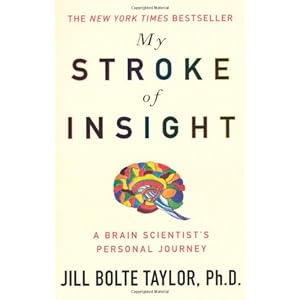I’ve been reading this book for Book Club (if you’re Katy or Deanna, stop reading now or read away and skip reading the book!) and I had high expectations, which can never be a good thing going into either a book or a movie. I’ve learned it’s much better to be pleasantly surprised by how good something is than disappointed by how less-than-good it is.
This book has all the makings of goodness – a positive message about the renewal capacity of the brain, the benefits of an optimistic outlook and the importance and availability of compassion and empathy.
If only it wasn’t written by this lady. I hesitate to critique an autobiography by someone who has done so much, and I’m sure she’s lovely in person and her story is truly amazing: she’s a neuroanatomist (brain scientist, essentially) who suffered a stroke at the age of 37 and watched both the unraveling and restitching of her own mind over 8 years with a kind of scientific curiosity. She writes to try to raise understanding in stroke victims and their caregivers, and her personal experience could definitely allow her to be a good voice for that.
However, the writing. UGH, my friends.
The book is unnecessarily science-y for what it sets out to do, which is let people know how someone with a stroke feels and what is most useful in reaching full recovery. The average person wanting to help their own mind or someone they know will not make it past Chapter 2. I am a stick-to-itty, read-it-all-once-I’ve-started reader and even I was skipping huge chunks of boringness, which is saying something since I find the brain and brain science fascinating.
Once you get past the brain anatomy lesson and feel you will not pass any imminent test, the story gets painfully redundant, and feels rather self-indulgent. Really, if she had talked about feeling like a liquid who was at one with the universe one more time…
If only both during and after recovery she didn’t continually mention the value of and need for “appropriate touch”, which only brings to mind the possibility of people inappropriately touching the mentally ill or mentally damaged, where if she had just said “touch” or “physical contact” I would have gotten it just fine.
And then she says things like “I unconditionally love my cells with an open heart and grateful mind. Spontaneously throughout the day, I acknowledge their existence and enthusiastically cheer them on…When my bowels move, I cheer my cells for clearing that waste out of my body. When my urine flows, I admire the volume my bladder cells are capable of storing”.
While I admire your enthusiasm Jill, I do not want to be your friend.
There are a couple of good back-to-back chapters that kept me going, along with the fact that I wanted to be able to discuss the book somewhat intelligently in a couple weeks, but I’m not recommending you go out and add it to your bookshelf unless you or someone you know has in fact experienced a stroke, and then you can read the 3 appendix pages and get some really valuable information.
If you can ignore her slightly (maybe more than slightly) annoying way of describing her experiences and own personal brilliance and slightly overboard love for her (now deceased) dog, you might want to read the rest…just enjoy the premise that we are all capable of being more caring and compassionate, more positive, and more able than we realize to recover from a massive blow to our brains.
That message is certainly worth spreading as the plasticity and capacity to recover of the human brain is truly incredible, but surely someone can rewrite this with jokes a little less nerdy and science a little less boring?
Also, I missed my bright green blog. You may have noticed.








The Brain that Changes Itself by Norman Doidge. Same wacky science, better jokes (less feely).
YES, that book is amazing, it even got Carl thinking we should take dance lessons to keep up our brains :)
Just grab something for The Cutest Blog website and change your blog background. :-)http://www.thecutestblogontheblock.com/free/wordpress-themes.html